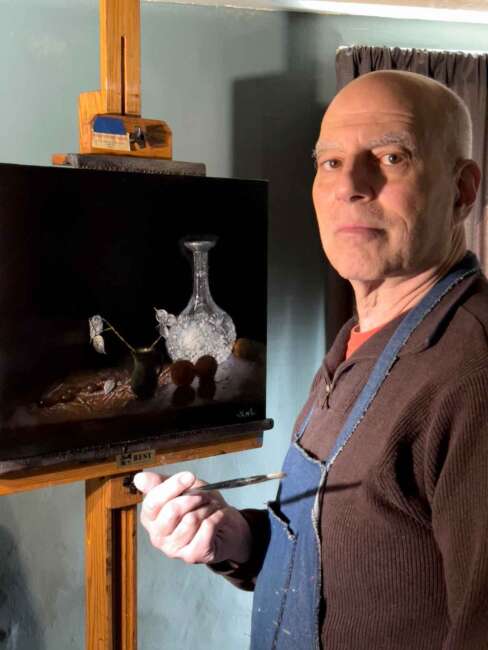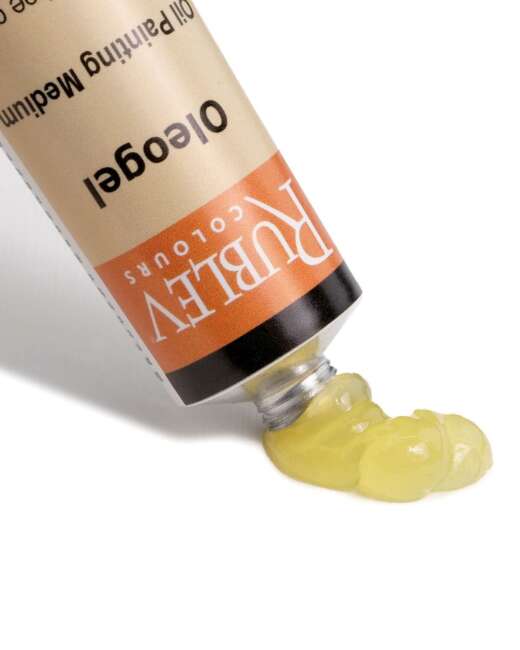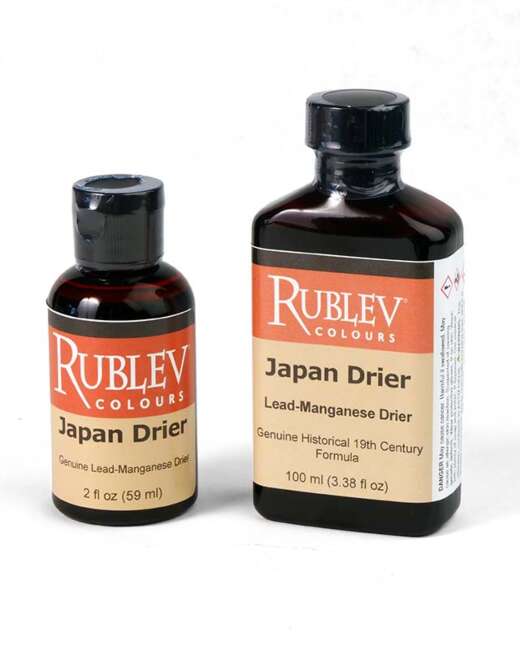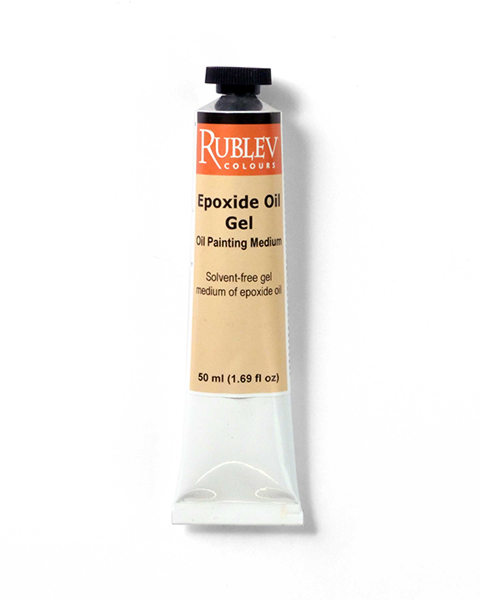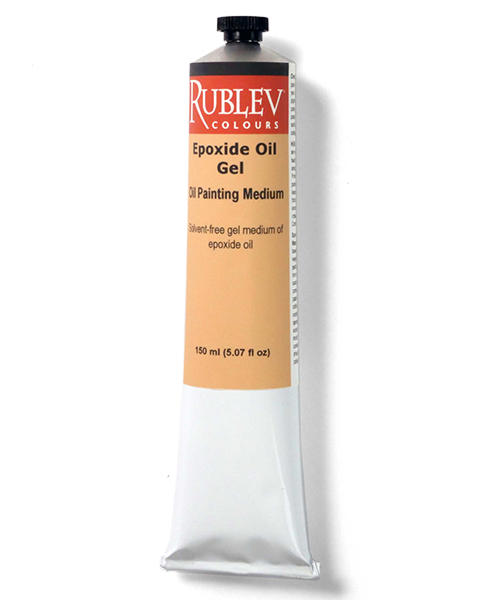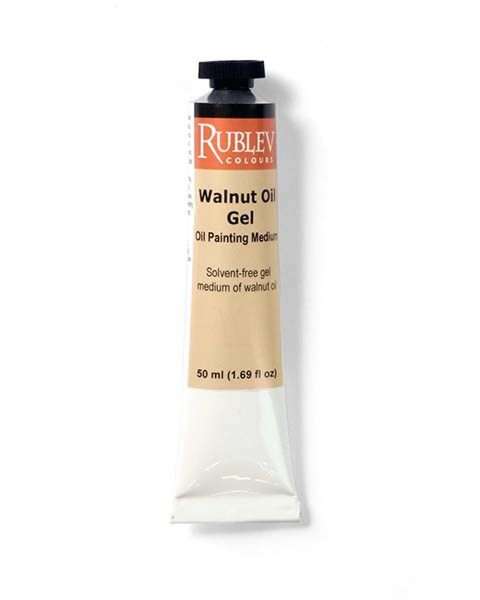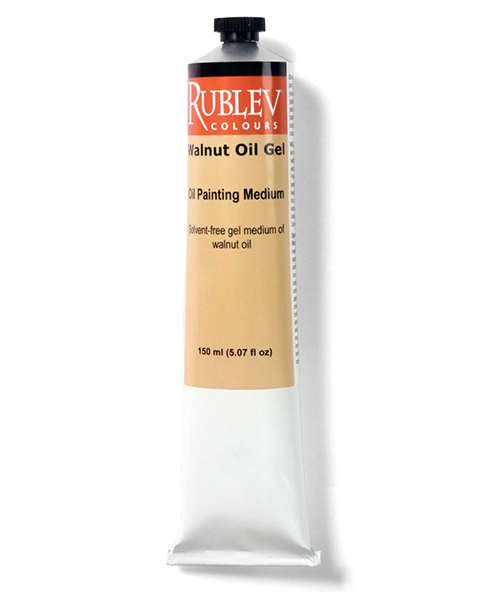Gel Mediums for Oil Painting

Gel painting mediums come in a variety of thicknesses and properties, but their primary purpose is to change the consistency or appearance of paint. Think of gel medium as transparent paint so that when added to oil colors, it diminishes the opacity of the color while helping to maintain its consistency.
Rublev Colours Oleogel
Oleogel is a thixotropic painting medium made with linseed oil and pyrogenic silica. Oleogel is a clear pale amber gel that adds transparency and a thixotropic body to oil, resin-oil, or alkyd paint. Add directly to your paint to give it transparency without thinning its consistency. Add pigments or extenders to thicken it to create impasto effects that do not sink in.
Oleogel does not contain driers, so it is safe to use in oil painting without the worry of cracking. You may find that Oleogel slows the drying time when added to paint in large amounts. However, most artists using Oleogel find that it does not extend the drying time of oil colors.
 |
| Oleogel is available in 50 ml and 150 ml collapsible aluminum tubes and eight and 16-ounce cans. |
 |
| Oleogel adds transparency to whites without losing the body of the paint. Oleogel in the center, Lead White on the left, and a mixture of Oleogel and Lead White on the right. The Flake White is stiff, plastic, and short, but when mixed with Oleogel, the mixture is semi-transparent, soft, yet sculptural. |
 |
| Oleogel increases transparency without flow out and leveling Rublev Colours French Raw Sienna at the left and a mixture of Oleogel and Raw Sienna on the right. Below each is a brush out of the above examples. Rublev Colours French Raw Sienna is long yet holding strokes well. When Oleogel is added to Raw Sienna, it increases transparency without causing the flow out and leveling of brushstrokes. |
How to Use
Mix directly into your paint right on the palette.
To make your paint with Oleogel, add directly to pigment powder until a stiff paste is obtained (almost the consistency of putty). Grind the paste with a muller on a flat surface before storing it in a collapsible tube. Some of its thixotropic properties will be temporarily lost when grinding Oleogel with a muller but should be restored when allowed to stand.
Where to Buy
Shop Now for
Rublev Colours Oleoresgel
Oleoresgel is a thixotropic gel painting medium made with bodied linseed oil, alkyd resin, odorless mineral spirits, and pyrogenic silica. Oleoresgel is a clear pale amber gel that adds transparency and a thixotropic body to oil, resin-oil, or alkyd paint. Add directly to your paint to give it transparency without thinning its consistency. Add pigments or extenders to thicken it to create impasto effects that do not sink in.
Oleoresgel does not contain driers, so it is safe to use in oil painting without the worry of cracking. You may find that Oleoresgel hastens the drying time when added to your paint on the palette.
 |
| Oleoresgel is available in 50 ml and 150 ml collapsible aluminum tubes. |
How to Use
Mix directly into your paint right on the palette.
To make your paint with Oleoresgel, add directly to pigment powder until a stiff paste is obtained (almost the consistency of putty). Grind the paste with a muller on a flat surface before storing it in a collapsible tube. Some of its thixotropic properties will be temporarily lost when grinding Oleoresgel with a muller but should be restored when allowed to stand.
Where to Buy
Shop Now for
Rublev Colours Walnut Oil Gel
Walnut Oil Gel is a thixotropic painting medium made with walnut oil and pyrogenic silica. Walnut Oil Gel is a clear pale amber gel that adds transparency and a thixotropic body to oil, resin-oil, or alkyd paint. Add directly to your paint to give it transparency without thinning its consistency. Add pigments or extenders to thicken it to create impasto effects that do not sink in.
Walnut Oil Gel does not contain driers or solvents, so it is safe to use in oil painting without the worry of cracking. Walnut Oil Gel will increase the drying time when mixed with oil colors.
 |
| Walnut Oil Gel is available in 50 ml and 150 ml collapsible aluminum tubes and 8-ounce cans. |
How to Use
Mix directly into your paint right on the palette.
To make your paint with Walnut Oil Gel, add directly to pigment powder until a stiff paste is obtained (almost the consistency of putty). Grind the paste with a muller on a flat surface before storing it in a collapsible tube. Some of its thixotropic properties will be temporarily lost when grinding Walnut Oil Gel with a muller but should be restored when allowed to stand.
Where to Buy
Shop Now for
Rublev Colours Epoxide Oil Gel
Epoxide Oil Gel is a thixotropic painting medium made with dicyclopentadiene copolymer linseed oil and pyrogenic silica. Epoxide Oil Gel is a translucent yellow gel that adds transparency and a thixotropic body to oil, resin oil, or alkyd paint. Add directly to your paint to give it transparency without thinning its consistency. Add pigments or extenders to thicken it to create impasto effects that do not sink in.
Epoxide Oil Gel does not contain driers or solvents, so it is safe to use in oil painting without the worry of cracking. Epoxide Oil Gel may decrease the drying time when mixed with oil colors. Epoxide Oil Gel is tacky, so we do not recommend adding more than 20 to 30% to your paint.
 |
| Epoxide Oil Gel is available in 50 ml and 150 ml collapsible aluminum tubes and 8-ounce cans. |
How to Use
Mix directly into your paint right on the palette.
To make your paint with Epoxide Oil Gel, add directly to pigment powder until a stiff paste is obtained (almost the consistency of putty). Grind the paste with a muller on a flat surface before storing it in a collapsible tube. Some of its thixotropic properties will be temporarily lost when grinding Epoxide Oil Gel with a muller but should be restored when allowed to stand.
Where to Buy
Shop Now for
Rublev Colours Wilson’s Medium
Wilson’s Medium is a clear, gel-like oil based on the 18th-century oil painting medium of thickened linseed oil, turpentine, and beeswax used by the English landscape painter Richard Wilson (1 August 1714–15 May 1782), who may reasonably claim the honor of being ‘the father of British landscape painting,’ and, according to George Field, also used by Joshua Reynolds. We’ve taken the original formula and improved upon it using the palest-bodied linseed oil, pure distilled gum spirits of turpentine, and rheological castor wax instead of beeswax.
The controlled hydrogenation of natural castor oil obtains castor wax. When molten, it is clear, transparent, and essentially colorless. Castor wax is practically odorless and has the same toxicity as linseed or other vegetable oils. Castor wax is much harder than most other waxes, so it can be used in much smaller amounts than beeswax to provide the same properties.
 |
| Wilson’s Medium is available in 50 ml and 150 ml collapsible aluminum tubes and 8-ounce cans. |
How to Use
Mix Directly with Oil Paints
No driers or resins are added to Wilson’s Medium so that it can be safely added to oil paints. Mix it directly with colors to give oil paint a buttery consistency that holds brushstrokes yet dries to a satin finish.
Use to Make Oil Paint
Add Wilson’s Medium to pigment and oil when making your paint. Paints often need the addition of rheological additives to prevent the settling of pigments during long storage periods and to impart specific behavioral characteristics, such as preventing slumping. Wilson’s Medium changes the viscosity of paint by thickening it and imparts rheological properties, such as shear thinning (thixotropy).
Use to ‘Oil Out’ or as a Painting Couch
Wipe a thin coat of Wilson’s Medium onto the surface of the dried paint just before painting a fresh layer. Wilson’s Medium restores dried paint’s matte appearance to a fresh appearance without making it glossy.
Where to Buy
Shop Now for
Questions and Answers
What is a thixotropic gel?
Thixotropy is the property of some fluids to change viscosity as they are agitated. The longer the fluid is agitated, the lower its viscosity. A gel is mostly liquid in composition but behaves more like a solid. When a thixotropic gel is agitated, such as manipulated with a palette knife or brush, it begins to flow, but when the agitation is stopped, it regains its former viscosity and stiffens.
What are the functional properties of gel mediums?
Gel mediums increase the transparency of oil colors without making the paint more fluid, such as when adding drying oil to increase the transparency of a color. This is advantageous when you want a transparent layer of color without making the paint runny. The pyrogenic silica in these mediums adds a little drag while brushing, and its transparency creates beautiful possibilities for layered painting techniques.
Can I use gel mediums to make opaque impastos?
All gel mediums increase the transparency of colors. They are soft gels so that as you add more to your paint, the softer and more transparent it will become. For heavy paint applications, such as impastos or textures, we recommend adding calcite (calcium carbonate) to gel mediums in combination with your oil colors. A more convenient method of building thick, opaque impastos is using Rublev Colours paste mediums, such as , instead of gel mediums.
I use a wax medium with my oil paint. Can Rublev Colours gel mediums be mixed with this medium?
All of our gel mediums are compatible with wax pastes and resinous mediums. We do not recommend heating Oleogel or Oleoresgel to mix it with wax, but rather adding the wax as a soft paste directly to the medium or melting the wax in linseed oil before adding it to Oleogel or Oleoresgel.
Can I add driers to Rublev Colours gel mediums to hasten to dry?
All the above gel mediums do not contain driers, so you can add driers to them to speed up their drying time. You will most likely find that driers are not needed. However, if you find driers necessary, add them as you typically use with oil paint. We recommend adding one or two drops of Cobalt System Drier for each tablespoon (5 ml) medium or combining medium and oil colors. Shop here for .



